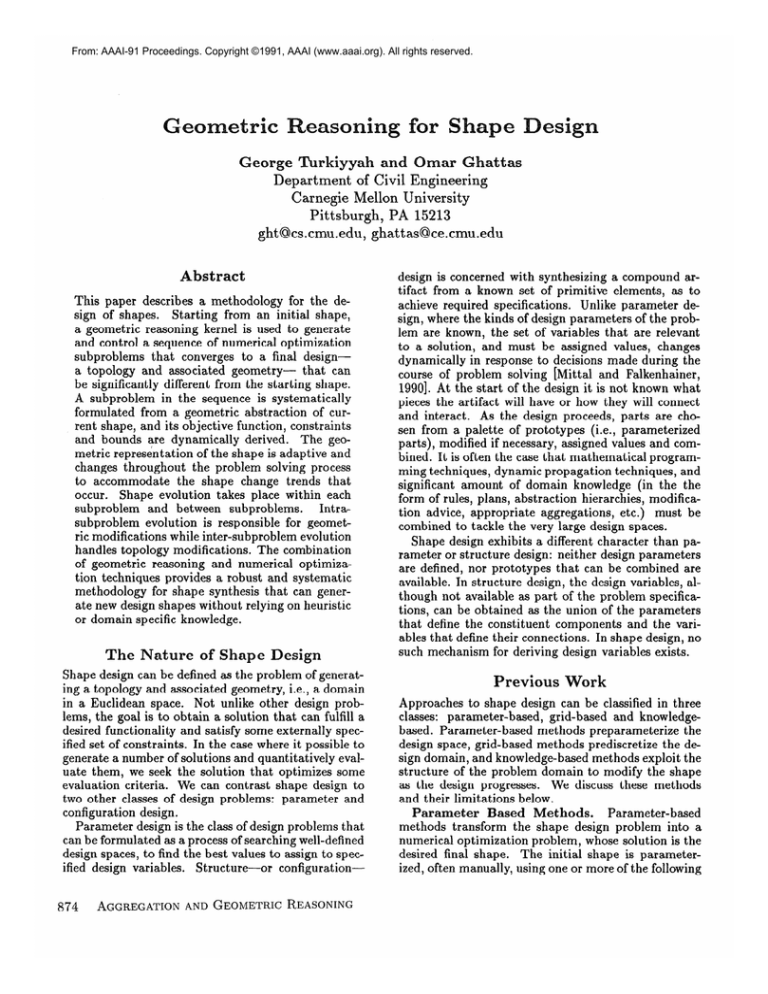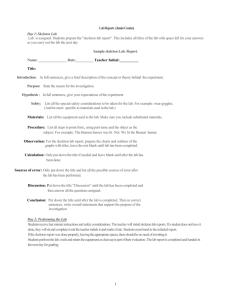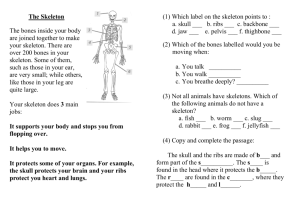
From: AAAI-91 Proceedings. Copyright ©1991, AAAI (www.aaai.org). All rights reserved.
rkiyyah and
George
Department of Civil Engineering
Carnegie Mellon University
Pittsburgh, PA 15213
ght@cs.cmu.edu,
ghattas@ce.cmu.edu
Abstract
This paper describes a methodology for the design of shapes. Starting from an initial shape,
a geometric reasoning kernel is used to generate
and control a sequence of numerical optimization
subproblems that converges to a final designa topology and associated geometrythat can
be significantly different from the starting shape.
A subproblem in the sequence is systematically
formulated from a geometric abstraction of current shape, and its objective function, constraints
and bounds are dynamically derived. The geometric representation of the shape is adaptive and
changes throughout the problem solving process
to accommodate the shape change trends that
occur. Shape evolution takes place within each
Intrasubproblem and between subproblems.
subproblem evolution is responsible for geometric modifications while inter-subproblem evolution
handles topology modifications. The combination
of geometric reasoning and numerical optimization techniques provides a robust and systematic
methodology for shape synthesis that can generate new design shapes without relying on heuristic
or domain specific knowledge.
The Nature
of Shape Design
Shape design can be defined as the problem of generating a topology and associated geometry, i.e., a domain
in a Euclidean space. Not unlike other design problems, the goal is to obtain a solution that can fulfill a
desired functionality and satisfy some externally specified set of constraints. In the case where it possible to
generate a number of solutions and quantitatively evaluate them, we seek the solution that optimizes some
evaluation criteria. We can contrast shape design to
two other classes of design problems: parameter and
configuration design.
Parameter design is the class of design problems that
can be formulated as a process of searching well-defined
design spaces, to find the best values to assign to specconfigurationified design variables. Structure-or
874
AGGREGATION
AND GEOMETRIC
REASONING
design is concerned with synthesizing a compound artifact from a known set of primitive elements, as to
achieve required specifications. Unlike parameter design, where the kinds of design parameters of the problem are known, the set of variables that are relevant
to a solution, and must be assigned values, changes
dynamically in response to decisions made during the
course of problem solving [Mittal and F’alkenhainer,
19901. At the start of the design it is not known what
pieces the artifact will have or how they will connect
and interact. As the design proceeds, parts are chosen from a palette of prototypes (i.e., parameterized
parts), modified if necessary, assigned values and combined. It is often the case that mathematical programming techniques, dynamic propagation techniques, and
significant amount of domain knowledge (in the the
form of rules, plans, abstraction hierarchies, modification advice, appropriate aggregations, etc.) must be
combined to tackle the very large design spaces.
Shape design exhibits a different character than parameter or structure design: neither design parameters
are defined, nor prototypes that can be combined are
available. In structure design, the design variables, although not available as part of the problem specifications, can be obtained as the union of the parameters
that define the constituent components and the variables that define their connections. In shape design, no
such mechanism for deriving design variables exists.
Previous
Work
Approaches to shape design can be classified in three
classes: parameter-based, grid-based and knowledgebased. Parameter-based methods preparameterize the
design space, grid-based methods prediscretize the design domain, and knowledge-based met hods exploit the
structure of the problem domain to modify the shape
as the design progresses. We discuss these methods
and their limitations below.
Parameter Based Methods.
Parameter-based
methods transform the shape design problem into a
numerical optimization problem, whose solution is the
desired final shape. The initial shape is parameterized, often manually, using one or more of the following
types of variables: coordinates of boundary points, distances along a direction from a fixed datum (e.g., rays
emanating from a central point, segments perpendicular to a straight line), coefficients of boundary curves
and surfaces such as splines or polynomials, etc. These
strategies for choosing the design variables have several shortcomings: they do not insure shape integrity
(the shape may overlap or fold upon itself); they restrict the range of shapes that can be reached, since
particular assumptions are imposed on the form of the
design space; and they lack adaptivity. Design variables are static and cannot take into account shape
evolution even though a different choice of design variables becomes more relevant as the design progresses.
Parameter-based methods are best used to fine-tune
the boundaries of an already designed shape rather
than generate new designs.
Grid Based Methods. Grid based methods prediscretize the design domain and use the resulting grid
as the design space of the synthesis process. Although
the grids can vary in shape (they can be Cartesian, triangular, hexagonal, polar, etc.), grid based methods all
operate at the cell level. Several grid-based approaches
have been proposed. One approach makes local design
decisions based on some criteria of an individual cell
and possibly its neighbors. For example, if an evaluation criterion at a cell is below a certain threshold
the cell is removed from the design. Other approaches
attach binary variables to each of the cells (0 denoting
that the cell is not part of the shape, 1 otherwise), or
equivalent continuous variables and formulate a mixedinteger programming problem whose solution is the final design. Deficiencies of grid-based methods include:
(1) geometric and other constraints cannot always be
imposed on the design and taken into account by the
design process; (2) grid-based designs are ambiguous
since it is not clear how to interpret the occupancy
grids generated, which often include isolated cells or
islands and other anomalies; and (3) if formulated as
optimization problems, they are computationally very
expensive.
Knowledge Based Methods.
Knowledge-based
approaches have been suggested for shape design.
Knowledge-based approaches rely on particular characteristics of the problem space to devise specific problem solving methods. For example, significant object
characteristics are often captured by a symbolic shape
description on which a variety of domain-dependent
operators apply [Murthy and Addanki, 19871. Other
approaches decompose the object to be designed, in a
domain dependent manner, into a set of subobjectseach of which can be described in terms of known functional parameters (often feature based descriptions),
that can be heuristically set and modified. Although
knowledge based approaches are reasonable for limited
domains, they lack the generality and robustness that
are needed for a general system. They suffer from the
combinatorial explosion of knowledge structures (rules,
Figure 1: Example of a Skeleton
operators, plans, critics, etc.) needed to cover significant domains.
The goal of this paper is to develop a methodology
for the design of shape that overcomes the deficiencies
of the above methods.
Geometric
ractions
for
An important element of shape synthesis is the shape
description. A robust approach to shape design must
include a geometric representation that is general purpose, simple to reason about, stable under minor object
changes and capable of topological and geometric evolution. As described above, the geometric descriptions
used by previous approaches to shape design (sequence
of boundary points, B-spline parameters, occupancy
grids, symbolic domain-specific representations, etc.)
have been inadequate for general synthesis. The shape
representation that we propose here is based on a geometric construct called the skeleton. The skeleton can
be viewed as an abstract canonical representation of
shape [Turkiyyah and Fenves, 19901.
The skeleton can be described in terms of the distance of a point z to a boundary A which is defined as
the minimum distance to any point on the boundary:
E A. Given a region with
d(z, A) = mind(z, z),Vz
boundary A, we can associate with every point of the
region its distance to A. For some points, however,
we notice that the distance is not achieved uniquely.
For such points more than one boundary point satisfies the minimum distance property: these “singular”
points define the skeleton. In other words, the skeleton
is the set of points that are minimally equidistant from
at least two boundary points [Duda and Hart, 19731.
An Example of a shape skeleton ia shown in Figure 1.
The skeleton of a shape is an intuitive and appealing representation. It is a first order approximation of
the shape and captures significant aspects of intrinsic
shape characteristics. For example, subshapes that are
elongated have a corresponding skeleton arc that follows their middle axis, pointed subshapes have a skeleton arc that follow the bisector and rounded subshapes
TURKIYYAH
& GHATTAS
875
have skeleton arcs that end at a point whose distance
to the boundary is equal to the minimum radius of
curvature of the rounded region. Moreover, the arcs of
the skeleton form a planar graph whose topology is directly related to the topology of the original shape. In
particular, the skeleton of a simply connected region is
a tree; the skeleton of a multiply connected region is a
graph with a number of cycles equal to the number of
holes in the original shape. Moreover, the skeleton is
information preserving: since each point 1: retains the
information on the minimum distance to the boundary, the original shape can be recovered as the union
of disks centered on the skeleton points. The notion of
a skeleton can be generalized to include both interior
and exterior skeleton arcs, where the exterior skeleton
is defined as the is the topological closure of the locus
of the maximal inscribable disks included in AC-the
complement of A.
Line segments that join a skeleton point to its corresponding boundary point will be termed rays. From
the definition of the skeleton, it follows that rays are
perpendicular to the boundary, provided that the corresponding boundary is locally smooth.
If the end
point of a ray is located at a position that has a discontinuous derivative (e.g., concave angular corner), then
the direction of the ray will fall between the right-side
and left-side perpendiculars to the boundary. If the
start and end points of a ray coincide (e.g., convex
corner), the direction of the ray will be defined as the
direction of the skeleton at that point. The skeleton
direction at such points has a slope equal to the average of the slopes of the right and left perpendiculars to
the boundary. Vertices of the skeleton are equidistant
from at least three boundary points.
The skeleton is particularly suited as a representation for shape design. It overcomes the restricted flexibility and robustness of other approaches because of
its:
Generality. The skeleton is a canonical representation of shape. It provides a general purpose mechanism for representing a geometric object by a graph.
Graphs are more easily amenable to manipulation in
design systems.
Adaptivity.
The structure of the skeleton graph
tracks object shape. The topology and geometry
of the skeleton intrinsically depend on object shape
and boundary curvature, and continuously change as
the object changes. Hence skeleton-based representations appear appropriate for following and defining
shape evolution during optimization.
Object Centeredness.
The skeleton of a shape is
unique and only depends on the spatial features of
the object independent of specific coordinate axes
choices or object locations in space. A corollary of
this, as we will describe in $4, is that the skeleton
can guarantee shape integrity throughout the design
process.
876
AGGREGATION
AND GEOMETRIC
REASONING
eseription
of the Methodology
Our shape synthesis methodology consists of iterating
on the following four steps: (1) computing the skeleton
of the current shape (techniques for generating skeletons are describes in [Turkiyyah and Fenves, 19901);
(2) choosing design variables based on the computed
skeleton; (3) formulating an optimization problem with
appropriate objective, bounds and constraints; and (4)
generating a new shape that becomes the basis of a new
design iteration.
The design process begins from an arbitrary initial shape and continues until no significant change in
shape and/or objective measure occurs, or until the
user is satisfied with the existing shape. Our initial experiments indicate that the starting shape is not very
important. To a large extent, a different initial shape
will typically take a different path to eventually arrive
at the same final shape, although we can imagine cases
where the final design is sensitive to the initial starting
shape.
Design
Variables
Design variables that describe the shape for design optimization will be chosen as skeleton rays (Figure 2).
As described in $2, rays are segments emanating from
points on the skeleton and perpendicular to the boundary (if the boundary is smooth), or along a direction
contained between the right and left perpendiculars to
the boundary (if the boundary is not smooth).
The procedure for choosing design variables can be
summarized as follows. First, from each vertex of the
skeleton use perpendiculars to the boundary -raysas variables. The vertices can be either triple points
or end points. They can be vertices on the interior or
exterior skeletons. Then, on each arc of the skeleton,
select a few points and use the rays emanating from
these points as design variables.
This strategy does not specify a particular scheme
for the number and distribution of design variables
along skeleton arcs. Such decisions could depend on
the nature of the problem, the total number of desired design variables, the required shape resolution,
the stage of the design, etc. A typical general-purpose
choice might be to choose points in the middle of the
arcs and then add additional middle points to each
subarc recursively. Other choices could take into account the nature of the distance function on the arc
and choose points at the locations where the function
has an extremum value. Our results indicate that the
particular scheme used to choose design variables along
skeleton arcs is not important to reach the final shape.
The number and locations of skeleton rays used only
affects the number of design iterations it takes to reach
the final shape: we exchange fewer subproblems for
more work per subproblem resulting from a greater
number of variables.
Figure 2: Skeleton BmLd Design Variables
Subproblem
Formulation
Once the design variables are chosen, the next step is
to formulate a numerical optimization problem whose
solution can improve the current shape. To define a
numerical optimization problem, we need to impose
appropriate lower and upper bounds on design variables, and express the objective and design constraints
in terms of these design variables.
An important characteristic of the skeleton is that
it is the basis for mescribing natural lower and unner
bounds on design* variables”that guarantee shape *integrity. Figure 2 illustrates how shape integrity can
be guaranteed if the values that the design variables
can assume are bounded from above and below by
the corresponding skeleton arcs. The interior skeleton is the lower bound of design variables emanating
from the interior skeleton as well as the upper bound
of design variables emanating from the exterior skeleton. Similarly, the exterior skeleton is the upper/lower
bound of design variables emanating from the interior/exterior skeleton. Qualitatively, the interior skeleton limit guarantees that the shape does not produce
“negative regions” by collapsing upon itself, while the
exterior skeleton limit guarantees that the shape will
not overlap, i.e., produce “double regions”.
It is typical in practical design problems that geometric shape constraints need to be imposed on the
design for manufacturability, fit, or other concerns.
These constraints are typically expressed globally and
are applicable to the overall object. Examples of such
constraints include such criteria as “no thickness shall
be less than two inches”, “no radius of curvature at
corners shall be less than one inch”, “object must fit
in a 10x10 space” etc. Because these design constraints
are often expressed as constraints on the final shape,
i.e., not attached to a particular design instance, or
particular design stage, we need to transform them at
every design iteration into constraints on design variables. The transformation of geometric shape con-
straints into constraints on skeleton variables involves
two steps. The first step is to identify the skeleton variables that model the particular feature referenced thickness along an extrusion, curvature at a corner, etc.
The second step involves expressing the criterion limits
as algebraic constraints in the optimization subproblem. In $5, we describe and give examples of two classes
of features that can be transformed into algebraic constraints on the design variables- thickness and overall
size. Notice that the referent of a constraint changes
as the design evolves and can only be properly defined
with respect to the current design. The definition on
another iterate in the design process may take a totally different form. Therefore, these transformations
must be done at each step of the design process, as the
shape evolves (giving rise to new object features), and
new variables become more appropriate descriptors of
the design. The classes of geometric design requirements that can be generically expressed (i.e., not with
respect to specific design variables) and automatically
transformed into algebraic constraints relating a subset of the corresponding design variables is an open
question. However, it is clear that all design criteria
that can be expressed as constraints on the location
of boundary points can be tranformed to constraints
on skeleton-based design variables by simple geometric transformations.
Generating
a New
Shape
Once the numerical optimization is formulated, it can
be solved using standard NLP techniques. Powerful
numerical optimization algorithms exist and are commercially available [IMSL, 19851. The optimization
procedure results in new values for the design variabIes. These values are interpreted as defining an improved shape that can then be used as the starting
point of another design iteration. This new starting
shape is qualitatively different from the initial one: indentations, protrusions, and holes can appear or be
removed.
For example, an interesting shape transformation
happens in the limiting case when related sets of design variables assume their lower and upper bounds.
For example, if two design variable rays originating
on the same skeletal point of a protrusion and facing
in opposite directions collapse to their common base
(i.e., both take on their lower bounds), the thickness
of the protrusion at that point becomes zero. If pairs
of variables along this protrusion all assume their lower
bounds, this is an indication that the protrusion is impeding progress towards the optimum, and should be
removed. A similar effect can fill indentations: sets of
variables originating from an exterior skeleton branch
reach their lower bound or variables originating from
interior branches reach their upper bound.
More importantly, topological changes can occur
when sets of design variables reach their upper or lower
bounds. Consider, for example, an internal hole. The
TURKIYYAH
& GHATTAS
877
12.3
of inertia about a horizontal axis. The design is constrained to fit in an exterior rectangular box of given
dimensions, and no thickness of any portion of the solid
may be smaller than a given threshold.
Figure 3 shows the evolution of the design (only the
upper half of the shape is shown-the lower half is symmetric). Starting from a rectangular initial shape (upper left), the skeleton is computed (dotted lines) and
design variables (arrows) are chosen as described in $4.
We have chosen only the interior skeleton to define design variables. Upper and lower bounds are imposed on
the design variables so that the shape stays within the
outer box (thin dotted line) and variables emanating
from the main stem of the skeleton have lower bounds
equal to half the minimum allowable thickness. Algebraic expressions defining the moment of inertia and
the area of the solid can be easily written in terms
of the design variables and the resulting optimization
problem is solved. The upper right diagram shows the
resulting shape (thick line) defined by the values of the
design variables at the end of the optimization. The
skeleton of the initial shape is also shown in the diagram for reference. A new iteration is then initiated
and results in the shape at the middle right. Notice
how the lower “protrusions” have collapsed onto the
skeleton and automatically disappeared. A third design iteration gets very close to the optimal wide flange
shape.
Design
Figure 3: Design Sequence of a Wide Flange Section
hole has a corresponding (exterior) skeleton subgraph
that defines the upper bounds on all design variables
originating in the interior and terminating on the hole
boundary. When these design variables reach their upper bounds, the hole is filled and should be removed.
This new shape has a reduced connectivity and initiates a new design iteration. Holes can also appear at
the end of the subproblem solution, as sets of related
design variables from different skeleton arcs reach their
upper bounds, and neighboring object regions join. §5
shows an example of hole formation.
Examples
This section illustrates the above methodology through
two shape design examples. The first illustrates how
large geometric shape changes can happen and how
constraints are imposed; the second example illustrates
how topological changes can occur during the design
process.
Design
of a Wide
Flange
Section
The goal of this design problem is to find the shape
of a solid of fixed area which maximizes the moment
878
AGGREGATION
AND GEOMETRIC
REASONING
of a
allow Tube
Section
The goal of this problem is to design a shape of maximum polar moment of inertia constrained to fit inside
a rectangular box. We initially constrain the area to
a fixed value. The sequence of design iterations is displayed in Figure 4. During the first three iterations
the shape moves away from the center (attempting to
maximize the polar moment of inertia); when no further progress can be made, it starts “flowing” along the
boundaries. The fourth iteration illustrates two important points. The first is that geometric constraints can
be introduced at any point in the design process and
need not be fixed throughout.
For example, we allowed the total area of the shape to be increased by
50%. The dynamic introduction of design constraints
is particularly important in interactive design environments. The second point is that cavities can be introduced in the design. In this case, two design variables
from different portions of the skeleton reach their upper
bounds (on the same exterior skeleton branch), hence
surrounding and creating a hole. The last iteration
further improves the design to generate a shape very
close to the optimal shape. The shape has undergone
a topological transformation.
Conclusions
In this paper, we have outlined a methodology for expressing and manipulating shape for design purposes.
Shape design is transformed into an iterative process:
J=5.33
............................
..............
A =4.0
J= 10.7
...............................................
at each iteration a design model is generated from the
skeleton, solved by numerical optimization, and the results interpreted to generate a new shape that can initiate a new design iteration. Advantages of the proposed
methodology include: (1) it does not pre-impose a particular structure on the design space (as in parameterbased methods), design domain (as in grid-based methods), and composition of the design (as in knowledgebased methods); (2) conditions that guarantee shape
integrity and validity can be systematically derived and
imposed at each iteration; (3) the methodology is capable of generating novel geometrical and topological
designs; (4) geometric constraints can be systematically incorporated in the design process; and (5) the
methodology is adaptive. Qualitatively, we can interpret the design process as a sequence of motions in a
design space. Given a current design description, we
move as much as possible in the design space using the
given represent ation. When no progress can be made
using the current design description, a new description
is generated to allow the shape to progress in another
direction in the design space.
We wish to thank Steve
Acknowledgements.
Fenves for challenging us with the topological design
problem. The support of the Ben Franklin Technology
Center of Western PA (RC7086), the NSF (DDM-9009
597), and the Engineering Design Research Center-an
NSF ERC at CMU-is gratefully acknowledged.
References
B. Chandrasekaran. Design problem solving: A task
analysis. AAAI Magazine, Winter 1990.
and
R. Duda and P. Hart. Pattern Classification
Wiley-Interscience Publications,
Scene Analysis.
1973.
S. Finger and S. Safier. Representing and recognizing
features in mechanical designs. In Second International Conference on Design Theory and Methodology. Chicago, 1990.
IMSL. User’s Manual.
Houston, Texas, 1985.
Joskowicz and S. Addanki. From kinematics to shape:
an approach to innovative design. In AAAI-88, 1988.
S. Mittal and B. Falkenhainer. Dynamic constraint
satisfaction. In Proceedings Eighth AAAI Conference,
volume 1. AAAI Press, 1990.
S. Murthy and S. Addanki. Prompt:
design tool. In AAAI-87, 1987.
An innovative
I. Pitas and A. Venetsanopoulos. Morphological shape
decomposition. IEEE Transactions on Pattern Analysis and Machine Intelligence, 12(l), 1990.
Figure 4: Design Sequence of a Hollow Tube
6. Turkiyyah and S. J. Fenves. Generation and
interpretation of finite element models in a knowledge based environment. Technical Report R-90-188,
CMU, 1990.
TURKIYYAH
& GHATTAS
879






